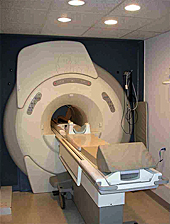
21-Ottobre-2011
A free-breathing radial 3D GRE sequence is feasible for abdominal MRI and may find application in imaging of patients who are unable to suspend respiration, especially children
.
The purposes of this study were to evaluate the feasibility of a free-breathing 3D gradient-recalled echo sequence with radial data sampling (radial 3D GRE) in abdominal MRI compared with a standard 3D GRE volumetric interpolated breath-hold examination (VIBE) sequence for imaging of cooperative patients and to perform a preliminary assessment in imaging of noncooperative patients.
MATERIALS AND METHODS:
Fifty-five consecutively registered patients who underwent unenhanced and contrast-enhanced abdominal MRI with the free-breathing radial 3D GRE technique constituted the study population. Two readers independently and blindly evaluated the images.
RESULTS:
Overall image quality with the contrast-enhanced radial 3D GRE sequence was lower than but rated at least nearly as good as that with the 3D GRE VIBE sequence (p < 0.0001). Higher scores were recorded for 3D GRE VIBE images with respect to pixel graininess, streaking artifact, and sharpness (p = 0.0009 to p < 0.0001). Except for sharpness of vessels on unenhanced images, results for the radial 3D GRE sequence did not differ significantly in the comparison of cooperative and noncooperative patients (p = 0.004). For imaging of noncooperative patients, radial 3D GRE images of children had higher ratings for shading (unenhanced, p = 0.0004; contrast-enhanced, p < 0.0001) and streaking artifacts on contrast-enhanced images (p = 0.0017) than did those of adults. Overall image quality was higher for pediatric patients. In lesion analysis, use of the 3D GRE VIBE sequence was associated with significantly greater detectability, confidence, and conspicuity than was use of the radial 3D GRE sequence (p = 0.00026-0.011).
CONCLUSION:
A free-breathing radial 3D GRE sequence is feasible for abdominal MRI and may find application in imaging of patients who are unable to suspend respiration, especially children.
Azevedo RM, de Campos RO, Ramalho M, Herédia V, Dale BM, Semelka RC.
Department of Radiology, University of North Carolina at Chapel Hill, 101 Manning Dr, CB 7510, 2006 Old Clinic Bldg, Chapel Hill, NC 27599, USA.
|